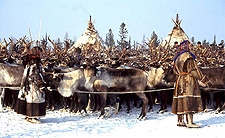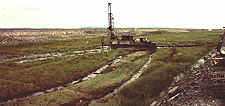Greening of the Arctic
Photo by Bruce C. Forbes/University of Lapland
Two Nenets women stand in front of their reindeer herd in the Yamal Peninsula, Russia.
Photo by Bruce C. Forbes/University of Lapland
Ruts and degrading permafrost which resulted from off-road vehicle traffic is clearly visible at a petroleum seismic survey site near Loborovaya on the Yamal Peninsula.
Additional reading:
Photo by Fred Daniels/University of Muenster, Germany
Bill Gould, forest ecologist, left, and Skip Walker, IAB, UAF, right, collect plants for vegetation studies in Isachsen, Ellef Ringnes Island, Nunuvut, Canada, July 2005.
Photo by Julie Knudson/UAF
Skip Walker, in the red shirt, describes the vegetation on a patterned-ground feature near Deadhorse, Alaska. Standing from left, are: Bill Krantz, University of Colorado; Hilmar Maier and Walker, IAB, UAF; Vladimir Romanovsky, GI, UAF; and Alexia Kelly, University of Virginia.
Photo by Fred Daniels/University of Muenster, Germany
Skip Walker samples arctic plant communities in Isachsen, Ellef Ringnes Island, Nunavut, Canada, in July 2005.
Story by Marie Gilbert and Julie K. Jackson, Institute of Arctic Biology
April 2007

Photo by Martha Raynolds/IAB
Skip Walker of UAF’s Institute of Arctic Biology is leading a team of scientists predicting human and environmental effects due to climate change in Russia’s Yamal Peninsula.
The Arctic appears to be getting greener, and the resulting changes in vegetation are expected to have profound consequences for the landscape, wildlife and people of the Arctic.
Scientists from the United States, Switzerland, Finland and Russia, led by Donald "Skip" Walker of the Institute of Arctic Biology at the University of Alaska Fairbanks, are applying their ecological, technological and anthropological expertise to understanding and predicting the human and environmental changes in the tundra regions of Russia’s Yamal Peninsula.
The Yamal, located entirely above the Arctic Circle in the extreme north of western Siberia, is a hot spot for examining the effects of both global warming and oil and gas development on ecosystems and Native people in the Arctic.
"The vegetation appears to be responding to climate change," Walker said. "Satellite-based data indicate a rapid greening is occurring in the Arctic, but when you look for ground documentation for this change there’s virtually nothing out there."
Using remote-sensing technologies, ground-level sampling and interviews with Native communities, Walker’s team is investigating how changes in vegetation and development are affecting the Yamal’s indigenous reindeer herders, called Nentsy, and how reindeer herding and development are affecting the Yamal.
"Surprisingly, there are no long-term repeated measures of biomass in the Arctic. We’ll be creating a baseline of vegetation data in a systematic way so that we can look at change over time," Walker said.
The Nentsy are nomadic reindeer herders who travel in extended family groups, called brigades, about 1,400 miles up and down the Yamal Peninsula each year. In summer, the brigades move from northern tundra pastures, where the reindeer have their calves, to the more protected subarctic evergreen forests, called taiga, in winter.
The Nentsy are renowned throughout the circumpolar Arctic as self-reliant, highly adaptable nomadic people whose social organization and primary economic activity rely on reindeer herding.
The Nentsy migrated to the Yamal Peninsula about a thousand years ago. By the early 1900s, a herd tended by a single brigade numbered in the thousands, but this was true for only a few; most family groups managed smaller herds.
Following Soviet Premier Joseph Stalin’s vision of socialist development in the early 1930s, the government forced Nenets reindeer breeders into collective farms, called kolkhozy. By the 1960s, the kolkhozy were converted into sovkhozy, or state-owned farms, and many Nenets herders became hired workers in these state-run reindeer breeding enterprises.
Despite being deprived of their lands, subsistence rights and reindeer, the Nentsy established a relatively stable economy based on sustainable fishing, hunting and reindeer breeding. That stability changed, however, with the discovery of Russia’s largest untapped gas deposits on the Yamal Peninsula in the 1980s and the collapse of the Soviet Union in 1991.
The Yamal herders have managed to adapt to these additional changes and now more than 1,000 nomadic households manage close to 300,000 animals.
Can the resilient Nentsy adapt to the challenges faced by a warming climate?
During the past 30-40 years, the Yamal region has experienced an overall warming comparable to that documented for northern Alaska and northwest Canada. Warming is affecting patterns of vegetation, which in turn affects reindeer herding.
"The Yamal is one of the best places in the Arctic to study the effects of climate change on tundra vegetation because it [includes] nearly the full arctic climate gradient in one landmass," Walker said.
The Yamal includes four different regions of distinct vegetation called bioclimate subzones. These range from low-shrub tundra in the south to ground-hugging dwarf shrubs on Bely Island in the Kara Sea.
Two major questions face arctic terrestrial ecologists and social scientists who are studying the Yamal. First, what will happen to the tundra regions as the global climate warms? And second, what will happen to the Nenets way of life as rapid industrial development and land-use changes proceed?
Oil and gas exploration has destroyed or made inaccessible hundreds of thousands of acres of pasture previously used by the Nenets herders, forcing them to concentrate grazing and migration routes in ever more limited areas. This intense grazing pressure has converted some of the Yamal’s tundra into deserts that are barren of forage or into shrubby expanses so dense that herders lose their reindeer. The Yamal’s bitter climate and nutrient-poor, sandy soils mean these disturbed sites may be slow to regenerate, if they come back at all.
Resource exploration has also led to the construction of roads and other infrastructure in this extremely sensitive landscape. These man-made structures divide the land and create barriers for the reindeer herders. Roads can be formidable obstacles for the Nentsy to negotiate during their twice-a-year migration because they travel using reindeer-hauled sleds loaded with heavy skin tents and belongings. Much of the landscape is rapidly eroding as the ice-rich permafrost, 980 feet deep in some areas, melts.
Walker’s team has established six research sites, each representing a different bioclimate subzone, along a 560-mile transect running north to south through the Yamal Peninsula. At each site the scientists will measure the amount of plant material, collect plant and soil samples and drill holes to monitor permafrost. Scientists will also analyze satellite data which contains information about landscape greenness, land-surface temperatures and sea-ice concentrations.
The team plans to make its first trip to the Yamal during the summer of 2007, visiting sites at Nadym and Kilometer 143, and at Vaskiny Dachi, which is located in the heart of the oil fields. Field work will continue during the next two summers.
Gary Kofinas, a UAF resource policy scientist, and Bruce Forbes, senior scientist at the University of Lapland in Finland, will interview Nenets herders to document local knowledge about ecological change and human adaptation to change. Local knowledge and historical perspectives are essential for interpreting data from satellite images and aerial photography.
"Our team of social scientists will be talking with herders and officials in the region to try to make sense of the changes Nentsy are seeing, and understand what these changes mean in terms of their social and ecological resilience," Kofinas said.
"We could do discipline-based studies, but we really need to understand the linkage between the human and the ecological. This project strives for science that integrates the parts," Kofinas said.
Uma Bhatt, an atmospheric scientist at UAF, is working with satellite data on sea-ice concentration to understand how retreating sea ice affects the bioclimatic subzones of the Yamal.
"Our basic hypothesis is to test if the Arctic really is greening," and if so, why, Bhatt said. "Is it because the [sea] ice has opened up earlier? That is, is the amount of sea ice strongly correlated with the surface temperature of the tundra?"
Walker notes that the research results can potentially be applicable to regions throughout the circumpolar North. By finding out what vegetation is present at each of the research sites, Walker’s team and other scientists will have more confidence in interpreting satellite and other remotely sensed data.
Understanding how and why the Arctic is greening will help scientists develop vegetation-change models that can be used to predict what the tundra will be in the future. Such information is expected to be useful for policy-makers and governments in managing arctic landscapes in a rapidly warming climate.
This project is funded by the National Aeronautics and Space Administration’s Land-Cover/Land-Use Change interdisciplinary science program, coordinated with the Northern Eurasia Earth Science Partnership Initiative, and is part of the Greening of the Arctic Initiative of the International Polar Year.
For more information please contact:
- Donald "Skip" Walker, Alaska Geobotany Center, Institute of Arctic Biology, University of Alaska Fairbanks, (907) 474-2459, ffdaw@uaf.edu
- Gary Kofinas, Institute of Arctic Biology and School of Natural Resources and Agricultural Sciences, University of Alaska Fairbanks, (907) 474-7078, ffgpk@uaf.edu
- Uma Bhatt, Atmospheric Science Program, Geophysical Institute, University of Alaska Fairbanks, (907) 474-2662, bhatt@gi.alaska.edu
- Bruce Forbes, senior scientist, Arctic Centre, University of Lapland, 358-16-341-2710, bforbes@ulapland.fi
- Marie Gilbert, public information officer, Institute of Arctic Biology, University of Alaska Fairbanks, (907) 474-7412, marie.gilbert@uaf.edu
- Julie K. Jackson, media student assistant, Institute of Arctic Biology, University of Alaska Fairbanks, (907) 474-7640, fsjkj7@uaf.edu
- Other participants
Other useful links:
- Alaska Geobotany Center
- Ealat Project
- Circumpolar Arctic Layer Monitoring Program
- National Aeronautics and Space Administration, Land-Cover/Land-Use Change
- National Geographic Geoguide on the Nentsy
- Northern Eurasia Science Partnership Initiative
- People of the Russian North and Far East
- The Yamalo-Nenetskiy Autonomous Okrug, Northwest Siberia







